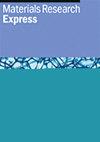In-situ synthesis of quaternary alkylammonium ligand capped organic-inorganic hybrid halide perovskite for high pure green luminescence in display application
IF 2.2
4区 材料科学
Q3 MATERIALS SCIENCE, MULTIDISCIPLINARY
引用次数: 0
Abstract
This study delves into the intricate dynamics of ligand engineering for the synthesis of Methyl Ammonium Lead Bromide (MAPbBr3) nanocrystals (NCs), which exhibit immense potential in optoelectronic and photovoltaic applications. Our focus centres on the role of the quaternary ammonium molecule CTAB as a ligand in stabilizing MAPbBr3 NCs. This also addresses the challenges related to the stability and surface defects of NCs that hinder their commercial viability. Employing a modified ligand-assisted reprecipitation technique (LARP) with a dual solvent system, we optimized the CTAB concentration to 0.05 mmol, resulting in MAPbBr3 NCs with an impressive 88% quantum yield. XPS and FTIR analyses confirm the presence and binding of CTAB on the NC surface. The MAPbBr3-CTAB NCs exhibit higher exciton–phonon binding energy, enhancing their optical properties. Despite an unfavourable geometric fit, CTAB is effective in surface defect passivation due to its binding, solvation, and desorption energy during the dynamic binding process. 2D-DOSY NMR reveals approximately 66% CTAB bound to the NC surface. A comparative study involving MAPbBr3-OA, OLA, and MAPbBr3-CTAB deposited on LEDs demonstrates the superior performance of the latter, achieving a luminous efficiency of 42.18 lm W−1 at 1.2 ml deposition. These findings highlight the efficacy of CTAB in achieving high-purity green luminescence, aligning with BT.2020 display colour standards and paving the way for advanced optoelectronic applications. The successful synthesis and improved performance of MAPbBr3-CTAB NCs underscore their potential as a promising material for future optoelectronic and photovoltaic technologies.原位合成季烷基铵配体封端的有机-无机杂化卤化物包光体,用于显示器中的高纯度绿色发光应用
本研究深入探讨了配体工程在合成甲基溴化铅铵(MAPbBr3)纳米晶体(NCs)过程中的复杂动态,MAPbBr3 纳米晶体在光电和光伏应用中展现出巨大的潜力。我们的研究重点是季铵分子 CTAB 作为配体在稳定 MAPbBr3 NCs 方面的作用。这也解决了与 NCs 的稳定性和表面缺陷有关的难题,这些难题阻碍了 NCs 的商业可行性。我们采用双溶剂系统的改良配体辅助再沉淀技术(LARP),将 CTAB 的浓度优化为 0.05 mmol,从而获得了量子产率高达 88% 的 MAPbBr3 NCs。XPS 和傅立叶变换红外分析证实了 CTAB 在 NC 表面的存在和结合。MAPbBr3-CTAB NCs 表现出更高的激子-声子结合能,从而增强了其光学特性。尽管 CTAB 的几何拟合并不理想,但由于其在动态结合过程中的结合能、溶解能和解吸能,它能有效地钝化表面缺陷。2D-DOSY NMR 显示,约有 66% 的 CTAB 与 NC 表面结合。一项涉及沉积在 LED 上的 MAPbBr3-OA、OLA 和 MAPbBr3-CTAB 的比较研究表明,后者的性能更优越,在沉积 1.2 ml 时,发光效率达到 42.18 lm W-1。这些发现凸显了 CTAB 在实现高纯度绿色发光方面的功效,符合 BT.2020 显示颜色标准,并为先进的光电应用铺平了道路。MAPbBr3-CTAB NCs 的成功合成和性能改进凸显了其作为未来光电技术材料的潜力。
本文章由计算机程序翻译,如有差异,请以英文原文为准。
求助全文
约1分钟内获得全文
求助全文
来源期刊

Materials Research Express
MATERIALS SCIENCE, MULTIDISCIPLINARY-
CiteScore
4.50
自引率
4.30%
发文量
640
审稿时长
12 weeks
期刊介绍:
A broad, rapid peer-review journal publishing new experimental and theoretical research on the design, fabrication, properties and applications of all classes of materials.
 求助内容:
求助内容: 应助结果提醒方式:
应助结果提醒方式:


